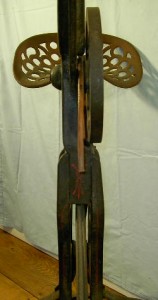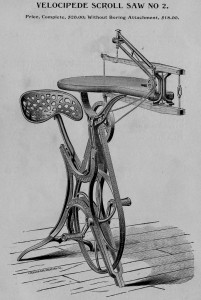To see a video comparing the #2 scroll saw and the #7 scroll saw, please Click Here
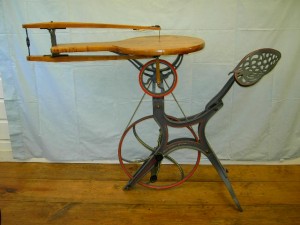 Perhaps one of the most well recognized of the commercial grade foot powered machines with its distinctive “tractor style” seat is the Velocipede #2 scroll saw. Barnes introduced this machine very early in their product line (about 1876) and continued producing them up into the 1930’s. It is likely that over 13,000 of these machines were produced. Today the #2 is desired by both collectors as well as those that want to demonstrate scroll sawing at woodworking shows and historic events or as a “draw” at a craft sale/show.
Perhaps one of the most well recognized of the commercial grade foot powered machines with its distinctive “tractor style” seat is the Velocipede #2 scroll saw. Barnes introduced this machine very early in their product line (about 1876) and continued producing them up into the 1930’s. It is likely that over 13,000 of these machines were produced. Today the #2 is desired by both collectors as well as those that want to demonstrate scroll sawing at woodworking shows and historic events or as a “draw” at a craft sale/show.
Sitting and pedaling like you were riding a bicycle comes naturally to most people. This makes it a very effective “means of converting motion” that can be used to power a scroll saw or lathe. It also does not have any “dead point.” While the up & down motion of a treadle may seem to be continuous, somewhere in the process the down motion must stop at least momentarily and change direction and then go up thus a “dead point” is created.
The adjustable seat and the convenient table height and position make sawing very easy on the operator. Patent # 175,010 of March 1876 and associated patent # 177,088 of May 1876 for “improvements in foot power” cover most of these points and are the primary basis of the design of the Barnes #2.
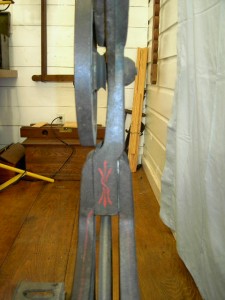 When first introduced, the #2 used a round belt like other early Barnes machines as a means of connecting the big pedal driven wheel to the smaller flywheel. (The picture to the left shows a section of the round belt hanging over the small flywheel and the picture on the right shows the pedal driving wheel and the small flywheel without the belt.) That small flywheel had a short pitman arm that then connected to the arms that moved the blade up & down. Round belts (essentially a larger version of what is used on a sewing machine) tended to slip as there was less contact between the belt and the flywheel when compared with the later flat belt drive with the sprocket and holes in the belt. These early machines, in very good original condition, are of more interest to collectors than users/demonstrators.
When first introduced, the #2 used a round belt like other early Barnes machines as a means of connecting the big pedal driven wheel to the smaller flywheel. (The picture to the left shows a section of the round belt hanging over the small flywheel and the picture on the right shows the pedal driving wheel and the small flywheel without the belt.) That small flywheel had a short pitman arm that then connected to the arms that moved the blade up & down. Round belts (essentially a larger version of what is used on a sewing machine) tended to slip as there was less contact between the belt and the flywheel when compared with the later flat belt drive with the sprocket and holes in the belt. These early machines, in very good original condition, are of more interest to collectors than users/demonstrators.
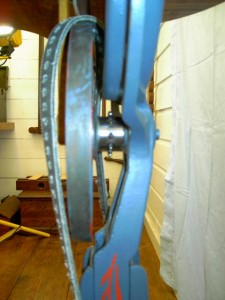 When Barnes obtained a patent for “Belt Gearing” in 1886 (# 354,849), they introduced what is commonly called the flat belt version of the #2. This “Belt Gearing” was simply the use of a flat leather belt with slightly oblong holes punched in it that went over a sprocket tooth pulley. These sprocket teeth went into the properly spaced holes which basically eliminated slippage and made the saw significantly more efficient.
When Barnes obtained a patent for “Belt Gearing” in 1886 (# 354,849), they introduced what is commonly called the flat belt version of the #2. This “Belt Gearing” was simply the use of a flat leather belt with slightly oblong holes punched in it that went over a sprocket tooth pulley. These sprocket teeth went into the properly spaced holes which basically eliminated slippage and made the saw significantly more efficient.
From the beginning, the #2 had a 24 inch swing (maximum distance from the edge of the work to the furthest place the blade could cut) and could take blades up to 7 inches long. Barnes claimed that the #2 could cut up to 3 inches of pine and proportionately cut hardwoods. (This same table top and arms were used on the #7 or Large Saw and the same arms were offered in the scroll saw attachment for the combined machine.)
Saw blades were available in various lengths from Barnes and others. They used a pin through both ends of the blade that simply rested in a small indentation in the top and bottom blade holders. This made for easy installation and removal of blades as well as allow for adjustments for blades of differing lengths. Today, standard coping saw blades work just great and are easily obtained.
To get the proper tension on the blade, the Barnes instructions said to adjust the top arm via the turnbuckle (wing nut on the early machines) at the rear of the arms to where the top of the saw blade when in the bottom blade holder just touched the bottom of the top arm. Then just depress the top wooden arm down and slip the top blade pin into the top blade holder. (There is no need to use the screw to close the top or bottom blade holder when using coping saw blades.) This may sound more complicated than it is but it really does work! And when you are finished sawing, be sure to release any tension so as to not warp the wooden arms.
When comparing the #2 saw to the other commercial grade scroll saw Barnes produced, the #7, there were four attachments that were only available for the #2 that clearly differentiated the two machines and really made it into a true multi-machine. These were a drill, the former. the smaller #1 scroll saw and the grinding/polishing machine.
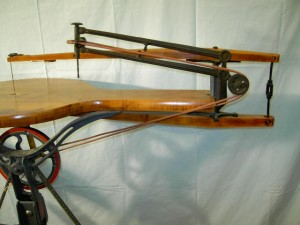 The most common was a boring attachment or better said, a drill attachment that mounted on the rear of the table. Drill bits were offered from 1/16 inch up to ¼ inch. The drill was connected to a small pulley made as a part of the small flywheel via a small round leather belt. To use the drill, the operator simply pushed the drill down to tension the belt and drill holes in the work. (A drill hole in the table on the right side of a table top is a dead give-a-way that a #2 did indeed have a drill attachment at one time.) By having a drill, the operator could drill a hole that would be used as a starting point for inside cuts.
The most common was a boring attachment or better said, a drill attachment that mounted on the rear of the table. Drill bits were offered from 1/16 inch up to ¼ inch. The drill was connected to a small pulley made as a part of the small flywheel via a small round leather belt. To use the drill, the operator simply pushed the drill down to tension the belt and drill holes in the work. (A drill hole in the table on the right side of a table top is a dead give-a-way that a #2 did indeed have a drill attachment at one time.) By having a drill, the operator could drill a hole that would be used as a starting point for inside cuts.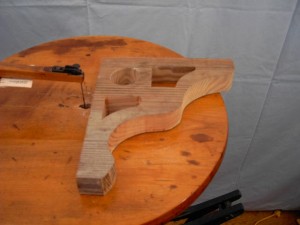 The “ginger bread” for a Victorian house made out of 1 1/2 inch yellow pine and shown to the right illustrates why a drill was very useful and just what the #2 saw could do.
The “ginger bread” for a Victorian house made out of 1 1/2 inch yellow pine and shown to the right illustrates why a drill was very useful and just what the #2 saw could do.
This option was offered during the entire time the saw was produced with only a minor design change. Since these drills had a tendency to drop down unexpectedly when sawing because of the vibration, they were likely removed and they tended to become separated from the saw itself. (Not really sure how useful the drill was when compared to simply using a hand drill which was much cheaper and was likely already in the shop or factory.)
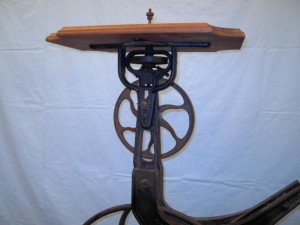 A former/shaper attachment shown here on the saw was offered for $15 on all the early, round belt models. In fact, the former was originally called the “Foot Powered Former #2” and if you bought it as a stand alone machine, it actually came on the same base as the #2 saw. To use the former attachment, you had to remove the scroll saw top and insert the former top into the base of the saw. Once Barnes began manufacturing the flat belt model #2 scroll saw, the method of powering the former changed and that necessitated a change in the design of the former as well. See the section on former/shaper for more information.
A former/shaper attachment shown here on the saw was offered for $15 on all the early, round belt models. In fact, the former was originally called the “Foot Powered Former #2” and if you bought it as a stand alone machine, it actually came on the same base as the #2 saw. To use the former attachment, you had to remove the scroll saw top and insert the former top into the base of the saw. Once Barnes began manufacturing the flat belt model #2 scroll saw, the method of powering the former changed and that necessitated a change in the design of the former as well. See the section on former/shaper for more information.
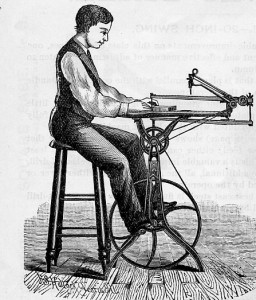 You could also buy the arms and table top of the # 1 amateur scroll saw shown in the catalog cut to the right and mount it to the bottom of the #2 after removing the normal top as with using the former attachment. This $9 option was only offered in the very early Barnes catalogs. Not really sure why this was offered as an option as the #2 could do everything the #1 could do and even more. That is one mystery we will likely never resolve.
You could also buy the arms and table top of the # 1 amateur scroll saw shown in the catalog cut to the right and mount it to the bottom of the #2 after removing the normal top as with using the former attachment. This $9 option was only offered in the very early Barnes catalogs. Not really sure why this was offered as an option as the #2 could do everything the #1 could do and even more. That is one mystery we will likely never resolve.
The top part of the grinding or polishing machine was also offered as an 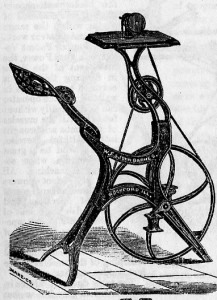 option on the round belt models. This $10 option was available to those that had a #2 scroll saw base and did not want to spring for the price of a complete grinder at $20. See the section on grinders & polishers.
option on the round belt models. This $10 option was available to those that had a #2 scroll saw base and did not want to spring for the price of a complete grinder at $20. See the section on grinders & polishers.
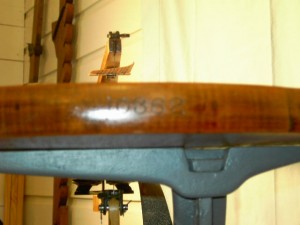 Barnes was faithful and took the time to serial number their machines. On the #2, the serial number was stamped into the front of the table and is generally very visible assuming the table is original. (Above the table you can see the top arm with the dust blower with a card inserted in it.)
Barnes was faithful and took the time to serial number their machines. On the #2, the serial number was stamped into the front of the table and is generally very visible assuming the table is original. (Above the table you can see the top arm with the dust blower with a card inserted in it.)
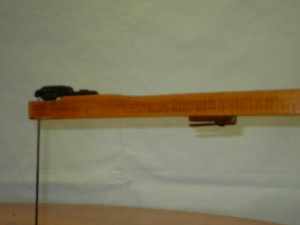 A much needed feature on a scroll saw is some type of dust blower to get the saw dust away so the operator can see what they are doing. The designs of these varied widely across manufacturers with most being fairly complex. Barnes, however, offered a very simple blower that was no more than a small piece of wood with a slit in it that was mounted under the top arm and near the blade. By inserting a card in the slot, the up and down motion of the arms basically created a “fanning action” that works fairly well. Replacement parts (the card) were readily available and inexpensive!
A much needed feature on a scroll saw is some type of dust blower to get the saw dust away so the operator can see what they are doing. The designs of these varied widely across manufacturers with most being fairly complex. Barnes, however, offered a very simple blower that was no more than a small piece of wood with a slit in it that was mounted under the top arm and near the blade. By inserting a card in the slot, the up and down motion of the arms basically created a “fanning action” that works fairly well. Replacement parts (the card) were readily available and inexpensive!
It appears that the tables and arms on these saws as well as the pitman arm were all made of hard maple. Very early catalogs state “tables of hardwood” while later ones clearly state the table is made of hard maple. (The arms were always made of hard maple.) Since the table tops were interchangeable between the #7 scroll saw and the #2 and the early #7 tables were made of ash (stated in the catalog), it could be that some very early #2 table tops were also made of ash.
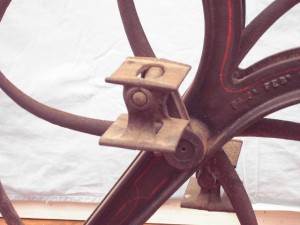 Pedal styles started out as the “oval” shape (see first picture of the #2 above) and they transitioned to the “square shape” shown here and them back to the oval shape. Not sure why the square pedals were introduced or why the change back.
Pedal styles started out as the “oval” shape (see first picture of the #2 above) and they transitioned to the “square shape” shown here and them back to the oval shape. Not sure why the square pedals were introduced or why the change back.
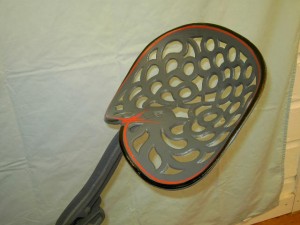 The tractor seat and stem used on the #2 is the same as the one used on the early round belt formers. When the transition occurred to the flat belt style, a slightly different stem was introduced for the former (Marked “Former” on the side) but it still will work on the #2 saw. It is common to see either of these stems on the #2 and the former. The seat itself was also used on the wood and metal lathes but with a different stem or support arm when compared to the #2 or former.
The tractor seat and stem used on the #2 is the same as the one used on the early round belt formers. When the transition occurred to the flat belt style, a slightly different stem was introduced for the former (Marked “Former” on the side) but it still will work on the #2 saw. It is common to see either of these stems on the #2 and the former. The seat itself was also used on the wood and metal lathes but with a different stem or support arm when compared to the #2 or former.
When first introduced, the #2 sold for $25 or $20 without the drill. By 1895, the price had dropped to $20 with the drill and $18 without.
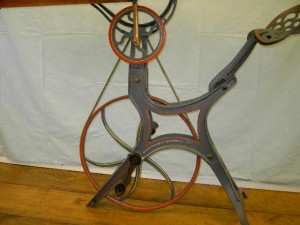 The #2 always had very nice pin striping. This pin striping tended to follow a theme and basically outline the edge of the machine but we must keep in mind that this was done by artists that likely did use some “poetic license” in their work. The base color of the early models was a burnt red and later models were predominately gray. Examples of other colors such as a brown have also been reported.
The #2 always had very nice pin striping. This pin striping tended to follow a theme and basically outline the edge of the machine but we must keep in mind that this was done by artists that likely did use some “poetic license” in their work. The base color of the early models was a burnt red and later models were predominately gray. Examples of other colors such as a brown have also been reported.
At 90 pounds and easily taken apart into a base, table top with arms and a seat, the #2 can very easily be loaded into a car or truck and transported or they can be packed for shipping. Just be careful as cast iorn can break VERY easily.
Here are a few catalog cuts advertising the Barnes #2 scroll saw from various catalogs Barnes sent out. Don’t you wish you could order one today at the advertised price.

